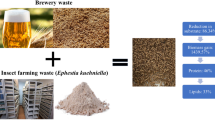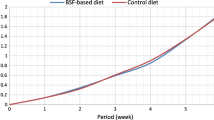Abstract
The growing interest in anaerobic digestion has led to an increase in the production of digestate that can be re-used. This work evaluates the possibility of using black soldier fly larvae (BSFL) to valorize biogas digestate, maize residue and alfalfa. The solid fraction of two digestates originating from two different biogas plants was used. Different diets (mixed or single substrates) were developed using digestate, maize residue and alfalfa. In addition, thermal hydrolysis as well as enzymatic hydrolysis were performed on the agricultural crops to break down fibers into reducing sugars, before being fed to BSFL. Chemical analysis of the substrates and a performance analysis were conducted. Application of the pretreatment on the agricultural crops improved larval growth on maize residue and alfalfa. Although larvae reached higher mass gain on pretreated maize residue and alfalfa than on non-pretreated crops, once these agricultural crops were mixed with digestate, performance decreased. Indeed, larval growth on digestate-based diets was very poor compared to the standard diet, with the average individual larval weight reared on digestate 1 and digestate 2 being 14.6 ± 2.54 mg and 46.43 ± 6.68 mg, respectively. A significant difference (p = 0.0018) was found between length gain of the two digestates, indicating that certain digestates lead to different BSFL yield. According to the results of this study, BSFL treatment of digestate was not efficient and further research is needed to elucidate the mechanisms preventing digestate from being effectively converted into larval biomass.
Graphical Abstract






Similar content being viewed by others
Data Availability
The datasets generated and/or analyzed during the current study are available from the corresponding author upon reasonable request.
References
ur Rehman, K., et al.: Black soldier fly, Hermetia illucens as a potential innovative and environmentally friendly tool for organic waste management: a mini-review. Waste Manag. Res. J. Sustain. Circ. Econ. 41(1), 81–97 (2023). https://doi.org/10.1177/0734242X221105441
Surendra, K.C., Olivier, R., Tomberlin, J.K., Jha, R., Khanal, S.K.: Bioconversion of organic wastes into biodiesel and animal feed via insect farming. Renew. Energy 98, 197–202 (2016). https://doi.org/10.1016/j.renene.2016.03.022
Liew, C.S., et al.: A review on recent disposal of hazardous sewage sludge via anaerobic digestion and novel composting. J. Hazard. Mater. 423, 126995 (2022). https://doi.org/10.1016/j.jhazmat.2021.126995
Torrisi, B., et al.: Physico-chemical and multielemental traits of anaerobic digestate from Mediterranean agro-industrial wastes and assessment as fertiliser for citrus nurseries. Waste Manag. 131, 201–213 (2021). https://doi.org/10.1016/j.wasman.2021.06.007
Gaj, K., Cichuta, K.: Combined biological method for simultaneous removal of hydrogen sulphide and volatile methylsiloxanes from biogas. Energies 16(1), 100 (2022). https://doi.org/10.3390/en16010100
Dahlin, J., Nelles, M., Herbes, C.: Biogas digestate management: evaluating the attitudes and perceptions of German gardeners towards digestate-based soil amendments. Resour. Conserv. Recycl. 118, 27–38 (2017). https://doi.org/10.1016/j.resconrec.2016.11.020
Vaneeckhaute, C., et al.: Nutrient recovery from digestate: systematic technology review and product classification. Waste Biomass Valoriz. 8(1), 21–40 (2017). https://doi.org/10.1007/s12649-016-9642-x
Leong, Y.K., Chang, J.-S.: Integrated role of algae in the closed-loop circular economy of anaerobic digestion. Bioresour. Technol. 360, 127618 (2022). https://doi.org/10.1016/j.biortech.2022.127618
Södergren, J., et al.: Food waste to new food: risk assessment and microbial community analysis of anaerobic digestate as a nutrient source in hydroponic production of vegetables. J. Clean. Prod. 333, 130239 (2022). https://doi.org/10.1016/j.jclepro.2021.130239
Akhiar, A., et al.: Anaerobic digestion industries progress throughout the world. Presented at the IOP Conference Series: Earth and Environmental Science, p. 012074. IOP Publishing (2020)
Bach, I.-M., Essich, L., Bauerle, A., Müller, T.: Efficiency of phosphorus fertilizers derived from recycled biogas digestate as applied to maize and ryegrass in soils with different pH. Agriculture (2022). https://doi.org/10.3390/agriculture12030325
Sfetsas, T., et al.: A review of advances in valorization and post-treatment of anaerobic digestion liquid fraction effluent. Waste Manag. Res. 40(8), 1093–1109 (2022). https://doi.org/10.1177/0734242X211073000
Gurmessa, B., et al.: Post-digestate composting benefits and the role of enzyme activity to predict trace element immobilization and compost maturity. Bioresour. Technol. 338, 125550 (2021). https://doi.org/10.1016/j.biortech.2021.125550
Tambone, F., Terruzzi, L., Scaglia, B., Adani, F.: Composting of the solid fraction of digestate derived from pig slurry: biological processes and compost properties. Waste Manag. 35, 55–61 (2015). https://doi.org/10.1016/j.wasman.2014.10.014
Samoraj, M., et al.: The challenges and perspectives for anaerobic digestion of animal waste and fertilizer application of the digestate. Chemosphere 295, 133799 (2022). https://doi.org/10.1016/j.chemosphere.2022.133799
Nkoa, R.: Agricultural benefits and environmental risks of soil fertilization with anaerobic digestates: a review. Agron. Sustain. Dev. 34(2), 473–492 (2014). https://doi.org/10.1007/s13593-013-0196-z
Lim, J.J., et al.: Cellulase pretreated palm decanter cake for feeding of black soldier fly larvae in triggering bioaccumulation of protein and lipid into biodiesel productions. Sustain. Energy Technol. Assess. 53, 102485 (2022). https://doi.org/10.1016/j.seta.2022.102485
Van Huis, A.: Edible insects: challenges and prospects. Entomol. Res. 52(4), 161–177 (2022). https://doi.org/10.1111/1748-5967.12582
Yang-Jie, D., Xiang, F.-M., Tao, X.-H., Jiang, C.-L., Zhang, T.-Z., Zhang, Z.-J.: A full-scale black soldier fly larvae (Hermetia illucens) bioconversion system for domestic biodegradable wastes to resource. Waste Manag. Res. 41(1), 143–154 (2023). https://doi.org/10.1177/0734242X221103936
Song, S., et al.: Upcycling food waste using black soldier fly larvae: effects of further composting on frass quality, fertilising effect and its global warming potential. J. Clean. Prod. 288, 125664 (2021). https://doi.org/10.1016/j.jclepro.2020.125664
Tan, J.K.N., et al.: Applications of food waste-derived black soldier fly larval frass as incorporated compost, side-dress fertilizer and frass-tea drench for soilless cultivation of leafy vegetables in biochar-based growing media. Waste Manag. 130, 155–166 (2021). https://doi.org/10.1016/j.wasman.2021.05.025
Menino, R., et al.: Agricultural value of black soldier fly larvae frass as organic fertilizer on ryegrass. Heliyon 7(1), e05855 (2021). https://doi.org/10.1016/j.heliyon.2020.e05855
Pas, C., et al.: Valorization of pretreated biogas digestate with black soldier fly (Hermetia illucens, L; Diptera: Stratiomyidae) larvae. J. Environ. Manag. 319, 115529 (2022). https://doi.org/10.1016/j.jenvman.2022.115529
Spranghers, T., et al.: Nutritional composition of black soldier fly (Hermetia illucens) prepupae reared on different organic waste substrates: nutritional composition of black soldier fly. J. Sci. Food Agric. 97(8), 2594–2600 (2017). https://doi.org/10.1002/jsfa.8081
Veldkamp, T., van Rozen, K., Elissen, H., van Wikselaar, P., van der Weide, R.: Bioconversion of digestate, pig manure and vegetal residue-based waste operated by black soldier fly larvae, Hermetia illucens L. (Diptera: Stratiomyidae). Animals (2021). https://doi.org/10.3390/ani11113082
Manurung, R., Supriatna, A., Esyanthi, R.R., Putra, R.E.: Bioconversion of rice straw waste by black soldier fly larvae (Hermetia illucens L.): optimal feed rate for biomass production. J. Entomol. Zool. Stud. 4(4), 1036–1041 (2016)
Elsayed, M., et al.: Innovative integrated approach of biofuel production from agricultural wastes by anaerobic digestion and black soldier fly larvae. J. Clean. Prod. 263, 121495 (2020). https://doi.org/10.1016/j.jclepro.2020.121495
Fu, S.-F., Wang, D.-H., Xie, Z., Zou, H., Zheng, Y.: Producing insect protein from food waste digestate via black soldier fly larvae cultivation: a promising choice for digestate disposal. Sci. Total Environ. 830, 154654 (2022). https://doi.org/10.1016/j.scitotenv.2022.154654
Liu, C., Wang, C., Yao, H., Chapman, S.J.: Pretreatment is an important method for increasing the conversion efficiency of rice straw by black soldier fly larvae based on the function of gut microorganisms. Sci. Total Environ. 762, 144118 (2021). https://doi.org/10.1016/j.scitotenv.2020.144118
Rahmani, A.M., Tyagi, V.K., Gunjyal, N., Kazmi, A.A., Ojha, C.S.P., Moustakas, K.: Hydrothermal and thermal-alkali pretreatments of wheat straw: co-digestion, substrate solubilization, biogas yield and kinetic study. Environ. Res. 216, 114436 (2023). https://doi.org/10.1016/j.envres.2022.114436
Statistics Canada. Corn, sweet corn. https://www.statcan.gc.ca/o1/en/plus/1526-corn-sweet-corn (2022)
OFA. Biomass Crop Residues Availability for Bioprocessing. Ontario Federation of Agriculture. https://ofa.on.ca/wp-content/uploads/2017/11/Biomass_Crop_Residues_Availability_for_Bioprocessing_Final_Oct_2_2012.pdf (2012)
Bakala, H.S., Devi, J., Ankita, Sarao, L.K., Kaur, S.: Utilization of wheat and maize waste as biofuel source. In: Srivastava, N., Verma, B., Mishra, P.K. (eds.) Agroindustrial waste for green fuel application, pp. 27–66. Springer Nature Singapore, Singapore (2023). https://doi.org/10.1007/978-981-19-6230-1_2
Hogsette, J.A.: New diets for production of house flies and stable flies (Diptera: Muscidae) in the laboratory. J. Econ. Entomol. 85(6), 2291–2294 (1992). https://doi.org/10.1093/jee/85.6.2291
Bosch, G., et al.: Standardisation of quantitative resource conversion studies with black soldier fly larvae. J. Insects Food Feed 6(2), 95–109 (2020). https://doi.org/10.3920/JIFF2019.0004
Sharma, S., Nandal, P., Arora, A.: Ethanol production from NaOH pretreated rice straw: a cost effective option to manage rice crop residue. Waste Biomass Valoriz. 10(11), 3427–3434 (2019). https://doi.org/10.1007/s12649-018-0360-4
Bruno, D., et al.: An in-depth description of head morphology and mouthparts in larvae of the black soldier fly Hermetia illucens. Arthropod Struct. Dev. 58, 100969 (2020). https://doi.org/10.1016/j.asd.2020.100969
Parra Paz, A.S., Carrejo, N.S., Gómez Rodríguez, C.H.: Effects of larval density and feeding rates on the bioconversion of vegetable waste using black soldier fly larvae Hermetia illucens (L.), (Diptera: Stratiomyidae). Waste Biomass Valoriz. 6(6), 1059–1065 (2015). https://doi.org/10.1007/s12649-015-9418-8
Nyakeri, E.M., Ayieko, M., Amimo, F., Salum, H., Ogola, H.J.O.: An optimal feeding strategy for black soldier fly larvae biomass production and faecal sludge reduction. J. Insects as Food and Feed (2019). https://doi.org/10.3920/JIFF2018.0017
Gold, M., et al.: Biowaste treatment with black soldier fly larvae: increasing performance through the formulation of biowastes based on protein and carbohydrates. Waste Manag. 102, 319–329 (2020). https://doi.org/10.1016/j.wasman.2019.10.036
Peguero, D.A., Gold, M., Endara, A., Niu, M., Zurbrügg, C., Mathys, A.: Evaluation of ammonia pretreatment of four fibrous biowastes and its effect on black soldier fly larvae rearing performance. Waste Manag. 160, 123–134 (2023). https://doi.org/10.1016/j.wasman.2023.01.033
Lu, Y., et al.: Effects of different nitrogen sources and ratios to carbon on larval development and bioconversion efficiency in food waste treatment by black soldier fly larvae (Hermetia illucens). Insects (2021). https://doi.org/10.3390/insects12060507
Parodi, A., et al.: Upgrading ammonia-nitrogen from manure into body proteins in black soldier fly larvae. Resour. Conserv. Recycl. 182, 106343 (2022). https://doi.org/10.1016/j.resconrec.2022.106343
Möller, K., Müller, T.: Effects of anaerobic digestion on digestate nutrient availability and crop growth: a review: digestate nutrient availability. Eng. Life Sci. 12(3), 242–257 (2012). https://doi.org/10.1002/elsc.201100085
Cai, M., et al.: Resistance of black soldier fly (Diptera: Stratiomyidae) larvae to combined heavy metals and potential application in municipal sewage sludge treatment. Environ. Sci. Pollut. Res. 25(2), 1559–1567 (2018). https://doi.org/10.1007/s11356-017-0541-x
Wu, N., Wang, X., Xu, X., Cai, R., Xie, S.: Effects of heavy metals on the bioaccumulation, excretion and gut microbiome of black soldier fly larvae (Hermetia illucens). Ecotoxicol. Environ. Saf. 192, 110323 (2020). https://doi.org/10.1016/j.ecoenv.2020.110323
Cho, S., Kim, C.-H., Kim, M.-J., Chung, H.: Effects of microplastics and salinity on food waste processing by black soldier fly (Hermetia illucens) larvae. J. Ecol. Environ. 44(1), 7 (2020). https://doi.org/10.1186/s41610-020-0148-x
Chozhavendhan, S., et al.: Current and prognostic overview on the strategic exploitation of anaerobic digestion and digestate: a review. Environ. Res. 216, 114526 (2023). https://doi.org/10.1016/j.envres.2022.114526
Ritigala, T., et al.: Optimized pre-treatment of high strength food waste digestate by high content aluminum-nanocluster based magnetic coagulation. J. Environ. Sci. 104, 430–443 (2021). https://doi.org/10.1016/j.jes.2020.12.027
Urbanowska, A., Polowczyk, I., Kabsch-Korbutowicz, M., Seruga, P.: Characteristics of changes in particle size and zeta potential of the digestate fraction from the municipal waste biogas plant treated with the use of chemical coagulation/precipitation processes. Energies 13(22), 5861 (2020). https://doi.org/10.3390/en13225861
Zhang, Z., et al.: Toxic effects of industrial flocculants addition on bioconversion of black soldier fly larvae (Hermetia illucens L.). Insects 13(8), 683 (2022). https://doi.org/10.3390/insects13080683
Acknowledgements
This research was funded by Fonds de recherche du Québec – Nature et technologies (reference 2021-PR-285600).
Funding
This research was funded by Fonds de recherche du Québec – Nature et technologies (Grant No. 2021-PR-285600).
Author information
Authors and Affiliations
Contributions
DB: conception, methodology, formal analysis, interpretation, writing—original copy. M-HD: conception, validation, writing—revision and editing. GV: writing—revision and editing. SB: supervision, project administration. DG: writing—revision and editing. M-AD: resource, writing—revision and editing. CV: resource, writing—revision and editing. KA: supervision, writing—revision and editing.
Corresponding author
Ethics declarations
Conflict of interest
The authors declare no conflict of interest.
Additional information
Publisher's Note
Springer Nature remains neutral with regard to jurisdictional claims in published maps and institutional affiliations.
Rights and permissions
Springer Nature or its licensor (e.g. a society or other partner) holds exclusive rights to this article under a publishing agreement with the author(s) or other rightsholder(s); author self-archiving of the accepted manuscript version of this article is solely governed by the terms of such publishing agreement and applicable law.
About this article
Cite this article
Brodeur, D., Deschamps, MH., Vandenberg, G. et al. Integration of Pretreated Crop Residues to Improve the Valorization of Biogas Digestate by the Black Soldier Fly (Hermetia illucens L.; Diptera: Stratiomyidae) Larvae. Waste Biomass Valor 15, 2671–2685 (2024). https://doi.org/10.1007/s12649-023-02340-z
Received:
Accepted:
Published:
Issue Date:
DOI: https://doi.org/10.1007/s12649-023-02340-z




